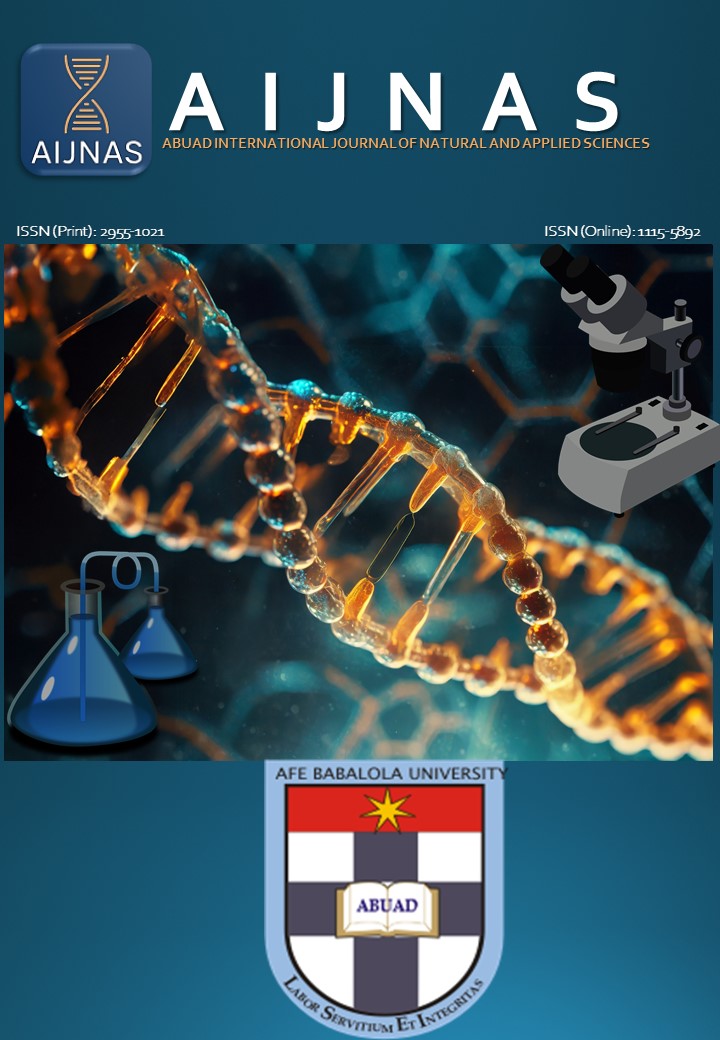Exploring the in-vitro and in-vivo trapanosomal Activities of Gacinia kola (Bitter kola) Seed Aqueous Extract using Animal Models Trypsnosomal
Main Article Content
Abstract
Trypanosomiasis (sleeping sickness) is a significant disease of economic and public health importance caused by Trypanosoma brucei gambianse parasite that affects humans. In 2014, WHO stated that 300,000 cases were reported to be diagnose and treated, and others died or lived with a disability based on the non-availability of the novel drugs, high toxicity, and development of resistance to the drug by the parasite. Therefore, using plant extract is fast becoming the choice for treating the disease. This study investigated the in-vitro and in-vivo trypanosomal activities of Garcinia kola (Bitter kola) aqueous seed extract as an alternative replacement for Diamininzene aceturate drug in the treatment of Trypanosomiasis Disease using animal modeling. The extract was obtained through the Maceration method with distilled water, and photochemical analysis was performed using various standard methods. In-vitro activity of the extract and Diaminizene aceturate drug was determined using rapid matching techniques at 3 hours post incubation with different doses of the extract and 3.5 mg/kg/bw of standarrd drug. In-vivo study was conducted using sixty-two (62) Wister rats divided into ten groups. Group A (standard control): noninfected and non-treated but received 10mL of distilled water; Group (B-H) were infected by intraperitoneal inoculation of 1mL of parasitized blood containing 1.0×105/ml of T. brucei gambianse parasites and treated with different doses of Garcinia kola seed extract, 200, 400 – 1400 mg/kg/bw; Group I: infected and treated with standard drug dose (Standard control); Group J: infected and untreated (Pathological control). The treatment lasted for 21 days at 3-day intervals. Data were analyzed statistically using Anova Turkeys post hoc SPSS version 2.0 software, with a significant difference at 0.01. The result revealed the photochemical components of the seed as Flavonoids, Steroids, tannins, saponins, Anthraquinones, glycosides, and carbohydrates. Garcinia kola seed extract exhibited trypanosostatic at doses of <400 mg and trypanocidal activity at doses > 400 mg in both in vitro and in v and in vivo, compared with trypanocidal activity of standard drug dose at 3.5 mg/kg/bw. Garcinia kola aqueous seed extract possesses trypanosostatic and trypanocidal effects in both In vivo and In vitro. Diamininzene aceturate drug proved to be trypanocidal at standard recommended dose. This study revealed that Garcinia kola aqueous seed extract might be used to design an alternative drug for treating trypanosomiasis disease at a lower concentration of 200mg/kg/BW.
Downloads
Article Details

This work is licensed under a Creative Commons Attribution-NonCommercial-NoDerivatives 4.0 International License.
Authors hold the copyright of all published articles except otherwise stated.
References
Abubarkar, A., Ogbadoyi, E.O., Ajayeoba, E.O., Okogun, J.I. and Gbodi, T.I. (2012). The Identification of Potential Antitrypanosomal Compounds in Tridax procumbens Extract. International Medical Aromatic Plant, 10: 20 - 28.
Adeyemi, O.S., Akanji, M.A. and Ekanem, J.T. (2012). Ethanolic Extract of Psidium guajava Influences Protain and Bilirubin Level in Trypanosome brucei brucei infected Rat. Journal of Biological Sciences, 12: 111 - 116.
https://doi.org/10.3923/jbs.2012.111.116
Atawodi, S.E., Musa, U.B. and Anyanwu, G.O. (2009). Comparative In-vivo Trypanocidal Activity of Petroleum Ether, Chloroform, Methanol and Aqueous Extract of Some Nigeria Savannah Plants. African Journal of Biotechnology, 24: 177-182.
Barett, M.P., Boykin, D.W., Brun, R. and Tidewell, R.R. (2002). Human African Trypanosomiasis Pharmacological, Reengagement with a Neglected Disease. British Journal of Pharmacology, 152 (8):115 - 117.
Bulus, T., Atawodi., S.E. and Mamman, M. (2015). Aqueous Extract of Terminalia avicennioides (guillperr) Ameliorates Some Pathological Conditions in T. brucei brucei infected Rats. Science World Journal, 10 (4): 11 - 18.
Delespaux, V. and Dekoning, H.P. (2007). Drug and Deny Resistance in African Trypanosomiasis. Drug, 10(1): 30-32. https://doi.org/10.1016/j.drup.2007.02.004
Emmanuel, O., Ogbadoyi, O., Adam, Y., Kabiru, O. and Roseline, F.O. (2011). Preliminary Studies of Antitrypanosomal Activity of Garcinia kola Nut Extract in Mice. Journal of Medicine and Medical Sciences, 2(1): 628-631.
Emmanuel, O.O., Adamu, Y.K. and Roseline, F.O. (2011). Preliminary Studies of the Antitrypanosomal Activity of Garcinia kola Nut Extract in Mice Infected with Trypanosome brucei brucei. Journal of Medicine and Medical Science, 2(1): 628 - 631.
Evans, W.C. (1996). Trease and Evans Pharmacology. WB. Saunders, University of Michigan, United States of America, pp 67 -76.
Farombi, E.O., Akani, O.O. & Emerole, G.O. (2002). Antioxidant and Scavenging Activity of Fllavoid Extraction (Kolaviron) of Garcinial kola Seed In vitro. Journal of Pharmacology Biology, 40(2): 107 -116.
Franco, J.R. (2014). Epidemiology of Human African Trypernosomiasis. Clinical Epidemiology, 6: 256- 261.
Igoli, J.O., Gray, A.I., Clements, C.J. and Moued, H.A. (2011). Anti Trypanosomal Activity and Cytotoxicity of Some Compound and Extract from Nigeria Medicinal Plant in Phytochemicals. Bioactivity and Impact on Heath Rasooli, 5: 345-358
Kennedy, P.G. (2013). Clinical Features, Diagnosis and Treatment of Human Africa Trypanosomiasis (Sleeping Sickness). Lancet Neurology, 12 (2):186-194.
https://doi.org/10.1016/S1474-4422(12)70296-X
Omwirhimen, E.M., Aseton, O.A. and James, S.A. (2017). The Photochemical Constituents and Relatives Antimicrobial Activities against Clinical Pathogens of Different Seed extract of Cola nitida (Heckel) grown in South West, Nigeria. Journal of Pharmacology and Phytochemistry, 6(1): 493 - 501.
Peter, J. and Milord, F. (1976). The Treatment of Human African Trypanosomiasis. Advances in Parasitology, 33: 1 - 4.
Peni, I.J., Ayaghomma, O.P., Elinge, C.M., Agaie, B.M., Elsa, A.I., Yusuf, H. and Ribah, I.M. (2012). Effect of Allium sativa Bulb Extract, Diaminazene aceturate and on Parasitemia and Biochemical Indices in Rat Experiment by Infected with Trypanosoma brucei brucei. Journal of Applied Pharmacological Sciences, 02(06): 112 - 115.
WHO (2005). Mortality and Health Data Statistic. Accessed 10 February, 2005.
WHO (2014). WHO Model Center Fact Sheet N 259. Trypanosomasis Human Africa Sleeping Sickness
(http//www.who.int/media center /fact sheets/ 259/en) World Health Organization. Wang, C.C. (2002).
Molecular Mechanism and Therapeutic Approach tothe Treatment of African Trypanosomiasis. "Annual Review of Pharmacology and Toxicology, 35: 93-102.




